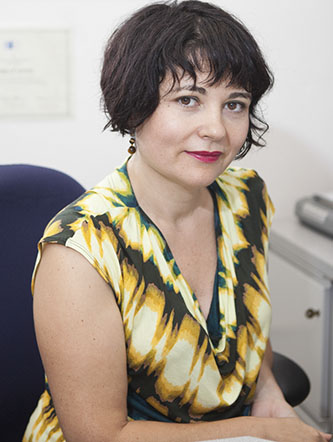Battling Cancer One Metal at a Time
Sept. 20, 2013

Chemistry Professor María Contel just received a $1.4 million grant from the National Institutes of Health to study metallo-drugs to battle prostate and kidney cancers.
Building on her research of gold compounds to combat cancer, Professor María Contel has scored a new, four-year grant from the National Institutes of Health (NIH) for $1.4 million.
The grant, which will be used to study gold-titanium complexes that might help in the effort to fight renal and prostrate cancer, bodes well for metallo-drugs, says Contel.
"It means the NIH appreciated our productivity under the first grant and warmed up to the idea of studying organometallic compounds as potential chemotherapeutics. It is perhaps changing minds at the NIH," she adds, noting that metal-based therapies, such as cisplatin, had been unfairly maligned.
Discovered in the early 1960s, cisplatin therapy was first used on cancer patients in 1978 and has saved many lives since. Cisplatin crosslinks DNA in several different ways, interfering with cell division by mitosis. The damaged DNA elicits DNA repair mechanisms, which in turn activate apoptosis—programmed cell death--when repair proves impossible. But as with any other platinum-based chemical compound, the very thing that makes it effective—its ability to interfere with DNA to cause the cancerous cells to self-destruct—is also what can cause severe damage.
"Cisplatin is not very selective and binds to all DNA," Contel explains, including healthy cells that may not be able to recover from the attack. "Also, some cancer cell lines (cultures of specific cancer cells) develop a resistance to it and use some proteins to repair its damage."
Combination therapeutics in medicine is a treatment that includes administering two or more drugs in order to reach different targets. For example, one metal could target the nuclei and the other could damage mitochondria, decreasing the chances for some cellular repair mechanisms such as DNA repair.
"For the new grant we got preliminary results on gold derivatives that incorporate a titanium center that inhibited certain mechanisms of prostate and kidney cancer in a way different to cisplatin while killing the cancer cells," Contel points out.
Contel’s team includes post-graduate, graduate, and undergraduate students. As her collaborator, Joe Ramos, the director of the Molecular Cancer Biology Program at the University of Hawaii Cancer Center, will be performing some preclinical advanced studies. Theodore Muth, a microbiology professor at Brooklyn College, will work with Contel on studies of metallic compounds as antimicrobial agents.
To turn any of the medicinal compounds Contel has been developing into a successful commercial drug is no simple task. There are many more steps, including pharmacokinetics—what the body does to the drug when it is administered—mechanistic tests, and clinical testing.
"If you’re amazingly lucky, you may see one of your findings enter the market. Only 5 of 5,000 compounds evaluated in preclinical studies will get the approval of the FDA. The whole process to develop a new drug takes an average of 10 to 15 years," says Contel.
Profit is not a scientist’s motivation, she explains. It is knowledge acquired from predecessors, and knowledge that can be left behind for others. A scientist’s studies may shed light on something other chemists or biologists are looking for.
For example, last year scientists discovered that Auranofin, a gold-based drug for rheumatoid arthritis approved by FDA in 1985, is terrific to combat Entamoeba histolytica, a protozoan intestinal parasite, and the causative agent of human amebiasis. Amebiasis is the fourth leading cause of death worldwide. Auranofin for about $2.50 a dose, could be used in developing countries afflicted with this type of health crisis.
"I’m learning cancer biology with my collaborators and colleagues and by reading books and journals," says Contel, who expects to focus next on prostate and triple negative breast cancer affecting the African-American population using ruthenium and gold compounds. "I’m learning everyday from my own work and the work from others. That is what science is for."






